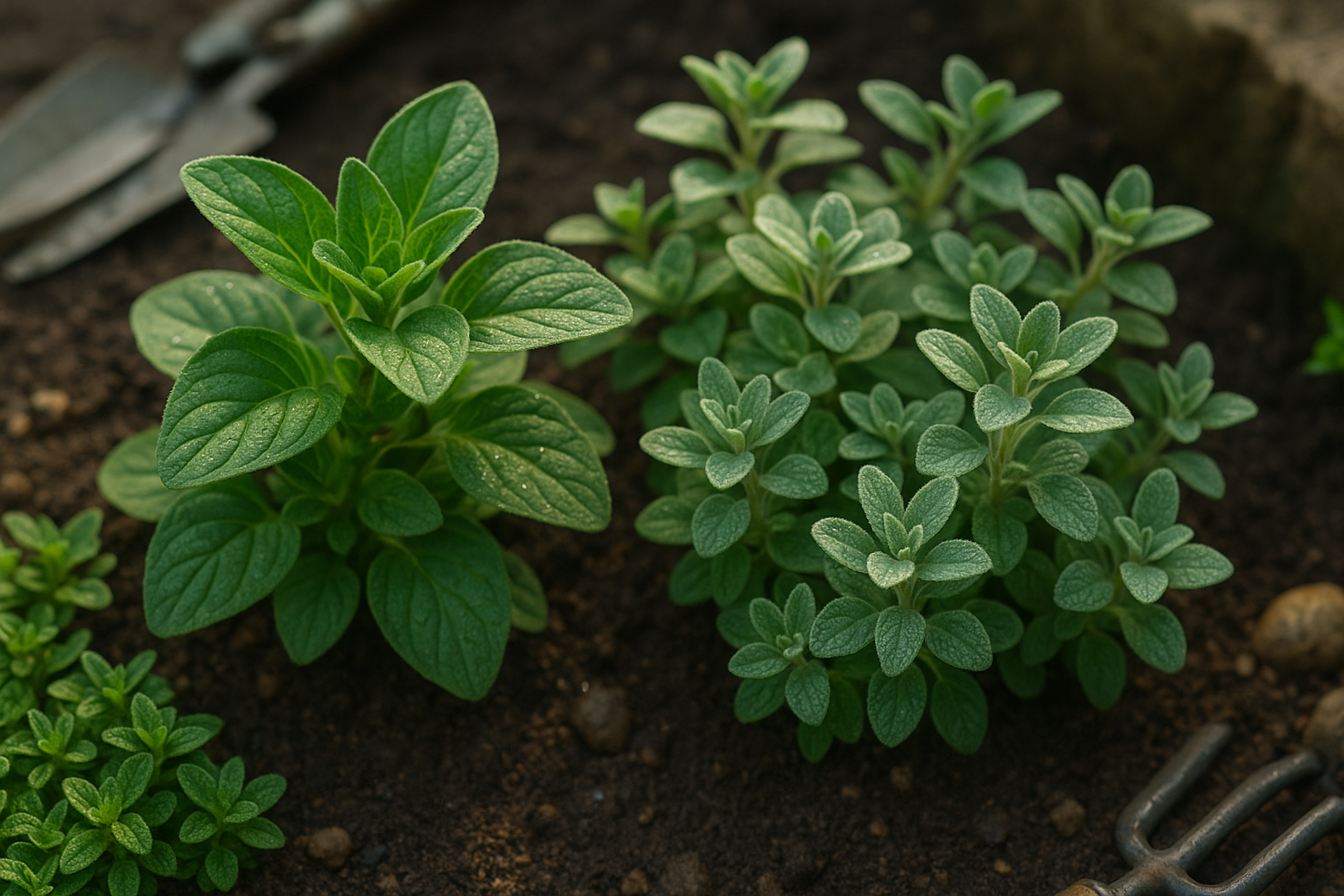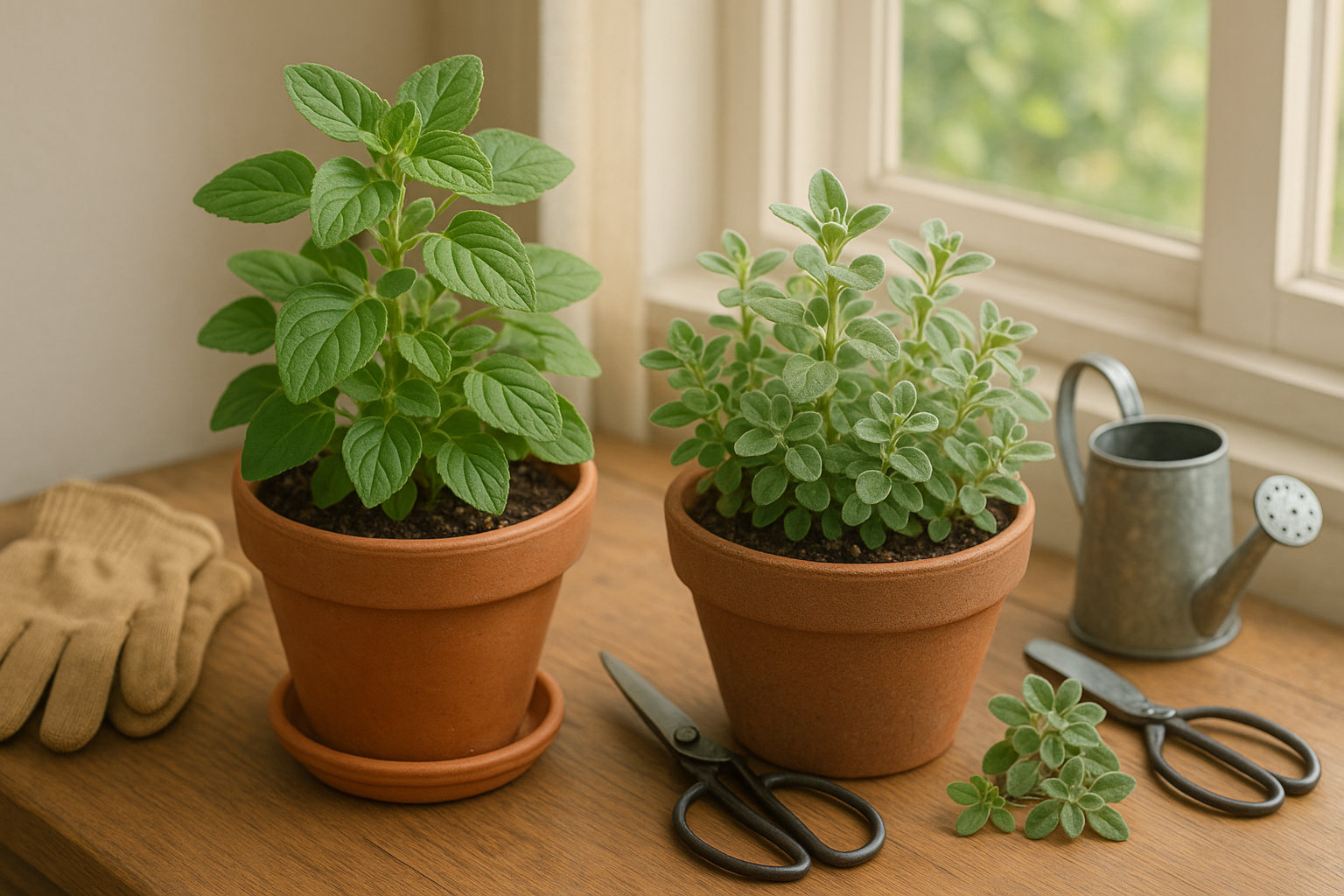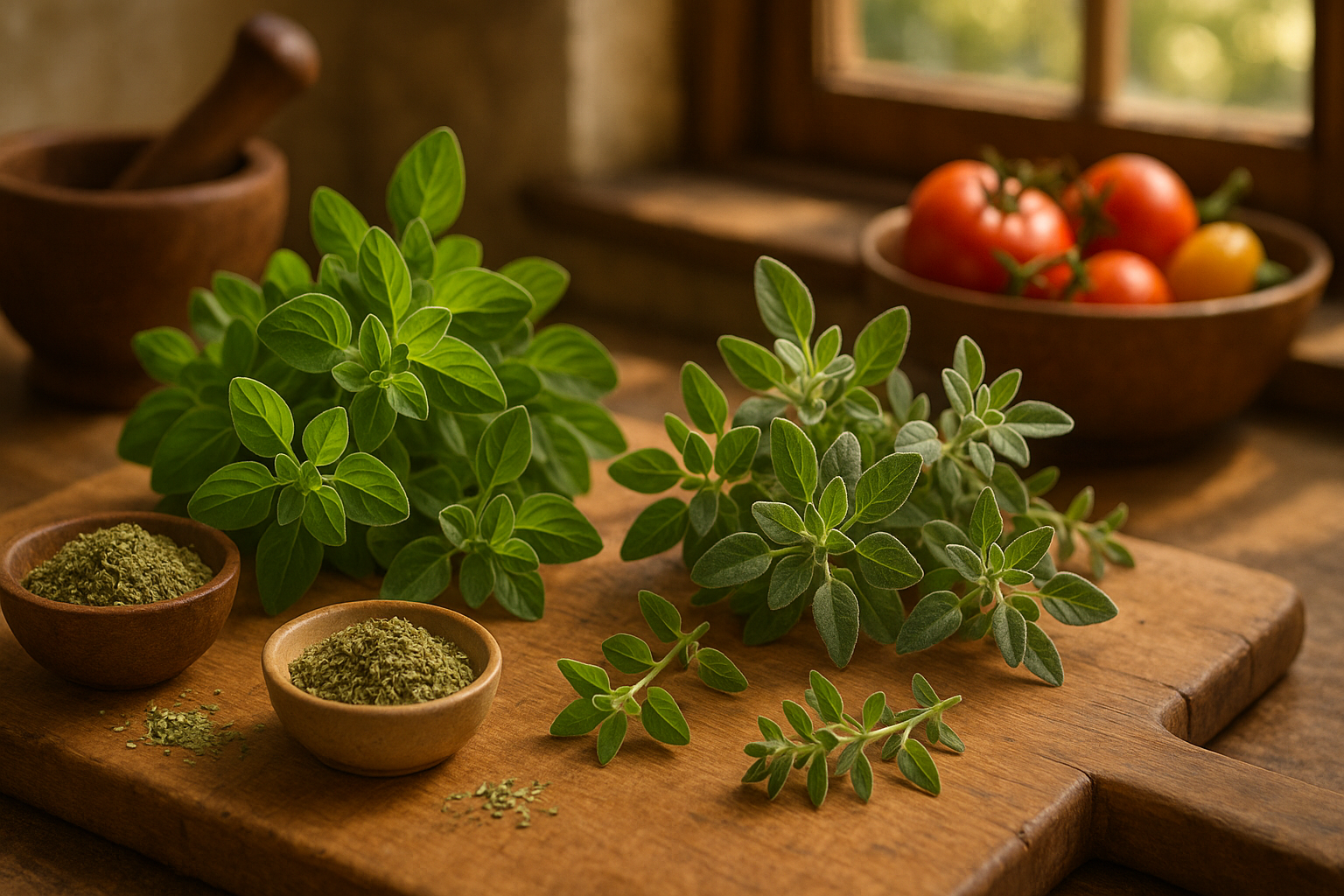Oregano vs Marjoram
If you’ve ever reached for a jar of dried herbs and wondered whether oregano and marjoram are really interchangeable, you’re not alone. These two popular herbs are often mixed up because they look similar and belong to the same botanical family. However, they actually have significant differences that can impact your recipes and gardening plans.
This article breaks down the key distinctions—covering everything from how oregano and marjoram taste, how they look, the best ways to use them in your cooking, what they need to grow well, and smart tips for substituting one for the other. By the end, you’ll feel confident knowing when to use each herb to bring out the best in your favorite dishes.
Introduction
Oregano vs. marjoram is a classic kitchen puzzle, with home cooks often mixing up these fragrant, leafy herbs. While they look and smell alike, knowing the difference between oregano and marjoram can make a real impact on your recipes. In this post, we’ll break down their unique flavors, explore how to tell them apart by appearance, and dive into when to use each herb in cooking. Plus, we’ll cover growing tips and the best substitutions if you’re missing one. Whether you’re a beginner or a foodie, you’ll leave with the confidence to choose the right herb every time.
Oregano and Marjoram

Oregano and marjoram are both aromatic herbs from the mint family, Lamiaceae. Although they’re often confused, they have distinct scientific classifications and culinary uses. Oregano, scientifically known as Origanum vulgare, is native to the Mediterranean region and Western Asia. It has been used to flavor food and medicine for thousands of years—think classic Italian pizza or Greek salads.
Marjoram, on the other hand, is Origanum majorana and originates from North Africa and Southwestern Asia. Its subtle sweetness is prized in French and Middle Eastern cuisine, especially in soups, stews, and sausages. Botanically, both belong to the Origanum genus, but marjoram’s specific species and milder flavor set it apart. In fact, marjoram is sometimes called “sweet marjoram,” while oregano is considered the more robust “wild marjoram.”
Visually, oregano has larger, broader, and slightly fuzzier leaves that are deep green. Marjoram’s leaves are smaller, more oval, and velvety with a grayish-green tint. When dried, oregano leaves keep their strong aroma and usually appear darker, while dried marjoram looks lighter and more delicate, with a subtler fragrance.
In the grocery aisle, oregano is the go-to for assertive, earthy flavors, and marjoram offers a softer, sweeter herbal note. To get the best results, check the label—and if you can, give the dried herbs a sniff to appreciate their unique characteristics before adding them to your dishes.
Taste and Aroma
Oregano and marjoram might look similar, but their flavor profiles and aromas are surprisingly distinct, making a big impact on your cooking. Oregano boasts a robust, assertive flavor with earthy, peppery, and slightly bitter notes that stand up well in hearty dishes. Its strength can sometimes overshadow more delicate ingredients, so it’s best used when you want bold flavors like in pizza sauce, grilled meats, or Greek salads.
Marjoram, on the other hand, is much milder and sweeter, with floral and woodsy undertones and only a hint of bitterness. This gentler herb shines in dishes where you want a more subtle, nuanced herbal taste—think roasted chicken, light soups, or Mediterranean veggies.
In terms of aroma, oregano has a sharp, pungent scent that instantly evokes classic Italian or Mexican cuisine, while marjoram smells warm, sweet, and almost citrusy, lending itself beautifully to French and Middle Eastern dishes.
To tell them apart in cooking, try crushing a few leaves between your fingers: oregano releases a bold, spicy fragrance, while marjoram is softer and sweeter. If you’re substituting one for the other, remember that marjoram is less intense, so you might need to use more, but be careful not to overwhelm delicate flavors.
The next time you cook, start by adding just a pinch of each to a dish and taste as you go—your palate will quickly learn to pick up on oregano’s punch and marjoram’s mellow charm.
Culinary Uses and Recipe Pairings
Oregano and marjoram each shine in the kitchen, bringing distinct flavors to dishes around the world. Oregano is a must-have in Mediterranean and Italian cooking, famously flavoring classics like pizza margherita, Greek salad, lamb kebabs, and tomato sauces. It pairs beautifully with robust meats such as beef, lamb, and pork, as well as earthy vegetables like eggplant, peppers, and mushrooms.
For more creative uses, try sprinkling oregano over roasted potatoes, mixing it into homemade vinaigrettes, or adding it to bread dough for a savory twist.
Marjoram, on the other hand, offers a sweeter, more delicate taste and shines in lighter dishes. It is traditionally used in German sausages, poultry stuffing, and French herb mixes like Herbes de Provence. Marjoram complements chicken, turkey, and veal, as well as mild vegetables including zucchini and carrots.
It’s a fragrant addition to creamy soups, bean salads, and even compound butters. For adventurous cooks, whirl marjoram into a citrus marinade or fold fresh leaves into whipped ricotta for crostini.
When choosing between fresh and dried herbs, remember:
- Fresh oregano tends to be more pungent than dried, so use it sparingly or as a finishing touch.
- Marjoram’s subtlety fades quickly when dried, so fresh marjoram is best for recipes where its gentle flavor can shine.
- Both herbs lose potency when cooked too long—add dried versions early in slow-simmered dishes and sprinkle fresh leaves at the end to preserve their delicate aromas and flavors.
Can Oregano and Marjoram Be Used Interchangeably?
Oregano and marjoram are closely related herbs and can sometimes be used interchangeably, but there are important differences to keep in mind. Oregano has a stronger, more pungent flavor, while marjoram is milder and slightly sweet.
You can substitute marjoram for oregano in most Italian and Mediterranean recipes—like tomato-based sauces, pizzas, or grilled vegetables—without a major impact, though the dish may taste a bit more delicate. However, when a recipe highlights the boldness of oregano, such as in Greek salads or certain robust meat dishes, marjoram might not provide enough punch.
Conversely, swapping oregano into a dish that depends on marjoram, like classic French or German sausages or delicate soups, can easily overpower the intended subtle flavors.
If you need to substitute fresh oregano for marjoram, use about two-thirds the amount (for example, 1 teaspoon of oregano for 1.5 teaspoons of marjoram), since oregano’s intensity is higher. For dried herbs, use a 1:1 ratio, but start with less and taste before adding more.
To balance flavors when swapping, add the substitute herb gradually, taste as you go, and consider adding a pinch of basil or thyme to round out the flavor profile.
Always remember, the key is to adjust according to your personal taste and the nature of the dish.
Growing Oregano and Marjoram

Oregano and marjoram are aromatic herbs that thrive in similar growing conditions, making them perfect companions in the home garden. Both prefer a sunny spot, soaking up at least 6 hours of sunlight daily. If you’re growing them indoors, a bright windowsill or a grow light will work well.
These herbs love well-drained, slightly alkaline soil—mixing in a bit of sand or perlite helps prevent soggy roots. Oregano seldom needs water once established, requiring only an occasional drink when the soil dries out. Marjoram benefits from slightly more moisture but still dislikes being waterlogged.
Harvest both herbs just as the flower buds form by snipping stems in the morning when their oils are most concentrated. Air dry small bundles in a well-ventilated area or use a dehydrator. Then store the leaves whole in airtight jars to lock in their flavor.
Oregano is generally hardier and can survive mild frosts, thriving in a range of climates. Marjoram, on the other hand, prefers warmer, frost-free zones and may need to be brought indoors for the winter.
For container gardening, use pots with drainage holes and a coarse potting mix. Whether indoors or out, be sure to rotate the plants regularly so all sides get sun. With these tips, even beginners can enjoy a steady supply of homegrown flavor year-round.
Health Benefits and Medicinal Uses
Oregano and marjoram, two popular herbs in Mediterranean cooking, are also powerhouses of health benefits with a long history in traditional medicine. Rich in antioxidants like thymol and carvacrol, these herbs help fight oxidative stress and support your immune system.
Oregano’s essential oils have antibacterial and antiviral properties, making oregano tea a folk remedy for soothing sore throats and minor coughs. Marjoram, often brewed as an herbal tea, is traditionally used to relieve digestive discomfort and promote relaxation with its calming compounds.
Both herbs are valued for their anti-inflammatory effects, which may help with joint pain or muscle aches when used topically in ointments. However, it’s wise to consume oregano and marjoram in moderation—especially their concentrated oils—as excessive use can sometimes irritate the skin or stomach.
If you’re pregnant or taking medications, check with your healthcare provider before adding large amounts to your routine.
Conclusion
Oregano and marjoram may look similar, but their flavors set them apart—oregano is bold and robust, while marjoram is gentler and sweeter. Both bring unique touches to the kitchen and garden; oregano shines in pizzas and tomato sauces, while marjoram adds subtle warmth to soups and roasted vegetables.
Don’t hesitate to try both and see how they transform your dishes or homegrown herb beds. Every cook and gardener has their own favorite, so feel free to experiment and find yours. We’d love to hear about your experiences or answer any questions—share your thoughts in the comments below!
